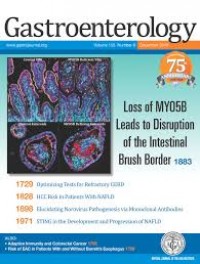Gastroenterology Q1 Unclaimed
Gastroenterology is the most prominent journal in the field of gastrointestinal disease. As the official journal of the AGA Institute, Gastroenterology delivers up-to-date and authoritative coverage of both basic and clinical gastroenterology. Regular features include articles by leading authorities and reports on the latest treatments for diseases. Original research is organized by clinical and basic-translational content, as well as by alimentary tract, liver, pancreas, and biliary content. Gastroenterology also bridges the gap between basic and clinical science by publishing on important topics such as pancreatitis and liver diseas It has an SJR impact factor of 7,195.
Gastroenterology focuses its scope in these topics and keywords: patients, cancer, liver, hepatitis, disease, receptor, bowel, cells, colorectal, gastric, ...
Type: Journal
Type of Copyright:
Languages: English
Open Access Policy: Open Choice
Type of publications:
Publication frecuency: -


2700 €
Inmediate OANPD
Embargoed OA0 €
Non OAMetrics
7,195
SJR Impact factor482
H Index480
Total Docs (Last Year)2082
Total Docs (3 years)12440
Total Refs17027
Total Cites (3 years)980
Citable Docs (3 years)7.19
Cites/Doc (2 years)25.92
Ref/DocOther journals with similar parameters
Nature Reviews Gastroenterology and Hepatology Q1
Gut Q1
Gut Microbes Q1
Clinical Gastroenterology and Hepatology Q1
Cellular and Molecular Gastroenterology and Hepatology Q1
Compare this journals
Aims and Scope
Best articles by citations
Both the lymphotoxin and tumor necrosis factor pathways are involved in experimental murine models of colitis
View moreReply to Dr. Paulley
View moreHelicobacter pylori requires fumarate reductase for acid resistance
View moreThe Fine Structure of Normal Mucosa in Human Gall Bladder
View moreThe Role of Matrix Metalloproteinase-7 in Redefining the Gastric Microenvironment in Response to Helicobacter pylori
View moreThe critical role of interleukin 4 but not interferon gamma in the pathogenesis of colitis in T-cell receptor a mutant mice
View moreCrohn's disease is associated with novel polymorphisms in the 5'-flanking region of the tumor necrosis factor gene
View moreThe Association of Gastric Epithelial Hyperplasia and Cancer
View moreSubepithelial collagen table thickness in colon specimens from patients with microscopic colitis and collagenous colitis
View moreAn Evaluation of the Problem of Hepatic Cirrhosis as Seen in Sao Paulo, Brazil
View moreLiver Function and Morphology in "q" Fever
View moreOil Granuloma of the Peritoneum
View moreActivation of Wnt Signaling Increases Numbers of Enteric Neurons Derived From Neonatal Mouse and Human Progenitor Cells
View moreGastric Helicobacter pylori infection accelerates healing of reflux esophagitis during treatment with the proton pump inhibitor pantoprazole
View moreIntestinal Malabsorption: First Manifestation of Amyloidosis in Familial Mediterranean Fever
View moreDeletion analysis of the p16 tumor suppressor gene in gastrointestinal mucosa-associated lymphoid tissue lymphomas
View moreNorfloxacin vs Ceftriaxone in the Prophylaxis of Infections in Patients With Advanced Cirrhosis and Hemorrhage
View moreSomatomedin-C levels in growth-impaired children and adolescents with chronic inflammatory bowel disease
View more616 - AMG 714 (Anti-IL-15 MAB) Halts the Progression of Aberrant Intraepithelial Lymphocytes in Refractory Celiac Disease type II (RCD-II): A Phase 2A, Randomized, Double-Blind, Placebo-Controlled Study Evaluating AMG 714 in Adult Patients with RCD-I
View moreNatural history of congestive gastropathy in cirrhosis
View moreSurface hydrophobicity of gastric mucosa in Helicobacter pylori infection: Effect of clearance and eradication
View moreWho Should Be Treated for Helicobacter pylori Infection? A Review of Consensus Conferences and Guidelines
View moreAbnormal expression of anion exchanger genes in primary biliary cirrhosis
View moreRoentgen Diagnosability of Gastric Ulcer
View more
Comments